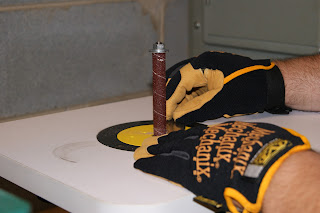Sorry I haven't written any articles lately. One reason is because at our school we were finishing up the summer semester and preparing for graduation. But the main reason is because afterwards, I took a little time off for a knifemaking class! The class was held at Montgomery Community College in Troy, NC. It was a bit of a drive for me to have to commute so I decided to stay in a hotel near Albemarle, about 20 minutes west of Troy. Troy is located in Montgomery County and a large section of the county is federal forest - the Uwharrie National Forest; part of the Uwharrie (Yew-are-ee) Mountains. I've lived there for part of my life in the Uwharrie Mountains (in Randolph County) and despite the heat, it was a pleasure returning. The Uwharrie Mountains have beautiful rolling small mountains, many rivers and lakes, loads of trails, and a lot of other opportunities for the outdoor enthusiast. Unfortunately, I was really busy during my class so I was unable to take much time off and photograph anything during my stay. Oh well, maybe later I'll go back and take some photos for another video slideshow. I'm actually about to leave tomorrow for a short stay up in the Appalachian Mountains for a bit. I sincerely hope that it'll be cooler there than it has been around here. These Southeastern summers are brutal and I don't deal with them very well.
So the class was Intro to Tactical Knifemaking taught by Barry and Phillip Jones of Jones Knives. The two brothers have more than 20+ years experience making knives. There were eight people in the class. Most were from NC but at least 2 came from Chattanooga, TN. The instructors were very knowledgeable and helpful.
The first day we started right off cutting the material and shaping the overall knife. The second day was spent mostly putting the grind on our blades and preparing them for heat-treating. We started working on the handle scales on the third day and finished up the fourth day on our knife edges. I think that the most challenging part about this process was putting the grind on the blade. I kept messing up the grind at first but practice and a little patience improved my technique. The next day I was able to finish up the grind and catch up with the rest of the class. I wished that I had taken my camera for some pictures of the process. A fellow student was doing that and he said that once he gets them edited that he'll send me some. Hopefully I'll get those soon.
Anyway, here it is! The first ever completed knife I've made. The blade is made of 440C 2" x 5/32" stainless steel and it is a full tang knife. Note that this is not the design I had been working on in my shop prior to the class. The overall length is 7-1/2 inches and the blade is 3-1/4 inches. Because of the integral blade guard, the handle just barely allows for a full grip of my sized hands. The design is Barry Jones' (I think). Even though we were supposed to make tactical knives (which I don't really care much for), I envisioned a small game skinning knife with this design. We heat-treated the blades first at around 1880 degrees Fahrenheit. They were then air quenched (basically left to cool on their own) and then we tempered them at about 350 degrees. My blade was one of few that actually came out of the furnace from the first heating in a pretty good state. Its appearance on the blade didn't change very much at all. The handle scales are black linen micarta. And the pins are brass. Some of the imperfections in the blade have been left because I want to make sure I learn from those mistakes I've made. Still, overall I had a good time and I learned a lot. Not bad for a first completed attempt! Not sure what I should name it yet. Any suggestions?














